
A Reverse Fault (animation)
By far, most mountains on the continents are of this type. They are produced by forces of compression and almost always at a plate boundary (the Rocky Mountains are an exception). This means that converging plates are responsible for this type of mountain.
When forces of compression act on rock, the rock may break, creating a reverse fault.

A Reverse Fault (animation)
Here is a good page dealing with faults
However, if the force is applied over a long time period the rock may actually fold and bend rather than break.
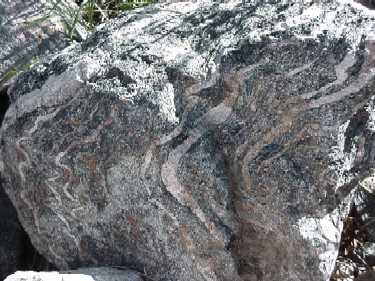
folds in rock (gneiss)
What decides if a rock will fault or fold?
We already know that when Continental Plates and Oceanic Plates
meet, the oceanic plate is subducted under the continental plate. The tremendous
forces of compression creates faults, folding, and uplift ... subducted crust
causes melting ... creating volcanoes ... basically, all "heck" breaks
loose.
This describes the Andes in South America, the Cascades in the Northwest US and the (inactive) Sierra Nevada and Coast Range of California.
 (animation)
(animation)
Most of the mountains formed in this collision are volcanic in nature
(from the melting below) but there is also major uplift of the continental
crust as the sea floor is driven under it. In fact, as the sea floor
is being driven down, the edge of the continental crust act like a "wedge"
which scrapes off the lighter sea floor sediments ramming into it.
This creates a thick deposit of sea floor sediments called an "accretionary
wedge". It should be clear that this material is simply recycled
continental rocks which was washed to the sea by erosion ... but now they
have been transformed to sedimentary (marine) rocks.
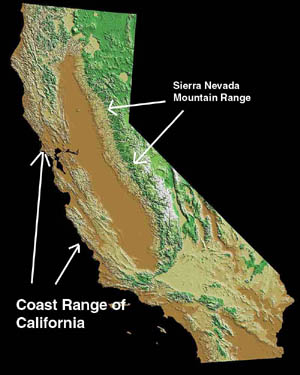
from USGS
The Sierra Nevada Mountains are highly eroded (volcanic) mountain roots which resulted when the Pacific Plate once was subducted under the area (it no longer active). The Coastal Range of California was an accretionary wedge forced up as the plates scrapped against each other and sediments accumulated.
When continents collide it gets even more dramatic. The Himalayas, Alps, and the Appalachians are examples.
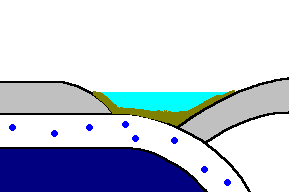 (animation)
(animation)
The ancient Greeks were puzzled as to why there were marine fossils
on summits of mountains. The collision of continental plates first
start out by putting the "big squeeze" on sections of oceanic crust.
This produces a thick accretionary wedge (on each continental margin) prior
to contact. This material is ultimately found on the summit of a
mountain peak. What happens when the continental plates meet?
The edges of the continents could fold upward to form mountains. An example
of this is the Appalachian Mountain range which was formed when the African
Plate collided with the North American Plate in the formation of Pangaea
(about 300 million years ago). The Himalayan Mountains formed as
a result of the collision of the Indo Australian Plate with the Eurasian
Plate about 50 million years ago.
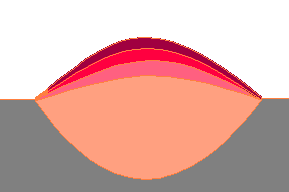 (animation)
(animation)Finally, as long as we are discussing crustal uplift ... we need to talk about the concept of isostasy. This is the idea that the crust is "floating" on the mantle (similar to the way an iceberg will float in the ocean). Icebergs have a lower density than the surrounding salty seawater so they float ... but always so that 9% of the ice volume is above sea level (which means that 91% is hidden in the water). What happens if some of the ice (at the surface) melts? The entire iceberg will move upward so 9% will again be above the surface. The same can be said about a boat floating in the water. If a passenger jumps off the boat, the boat responds by moving up slightly. It is believed that the crust in mountainous regions acts the same way. The concept that the crust will adjust itself in this way is known as isostasy.
Now imagine that erosion strips a great deal of material from a mountainous
region. The entire land mass will respond by uplifting. It
is believed that a similar reaction is occurring presently in regions
of northern Canada (Hudson Bay) because huge volumes of mass were "recently"
removed when the ice sheet retreated (over 300 meters of uplift has resulted).
Most of the time, mountains are formed at the edge of colliding
plates ... but not always. A section of a plate may experience horizontal
tectonic forces of
compression which make the surface warp upwards. When this happens
it is exposed to increased elevation and is subject
to greater erosion. The Bighorn mountains in Wyoming and the Black Hills (Mount Rushmore) of South Dakota
(both associated with the Rocky Mountains) are upwarp mountains.
 (animation)
(animation)


The Badlands in South Dakota is an area of sediments that is now exposed
to the surface. It was once material that was weathered and eroded
from the nearby Black Hills (an upwarped mountain range).
How is it possible to form a mountain far from an existing plate
boundary? When I first studied mountains, geologists were clueless because
this just didn't fit into the model of plate tectonics. Now geologists may
have an answer. It is believed that a section of oceanic plate is, indeed,
involved in the process. Suppose a section of oceanic plate was subducted
under the North American plate. If this section of oceanic plate slid
under the North American plate (like sliding one piece of paper under another)
instead of being forced deep into the mantle, you can account for the forces of
compression necessary to make these mountains. Apparently this is what
happened to form sections of the Rockies some 60 million years ago.
 (animation)
(animation)
Click here to see animations of faults
On occasion, crust can be pulled apart ... creating forces of tension. This may be caused by material below the surface welling upward, creating tension stress on the rocks above. A normal fault occurs when the rock splits due to these forces.
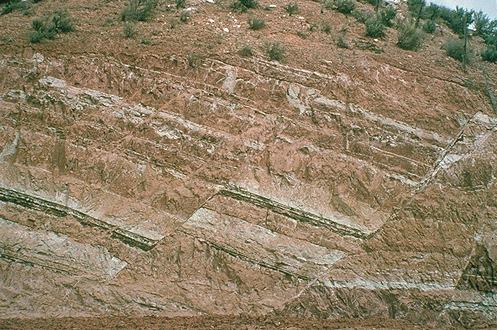
Permission from
http://www.gpc.edu/~janderso/physical/geo101.htm
click here

A Normal Fault (animation)
This can produce a long chain of mountains, the most famous are the Grand Tetons in Wyoming.
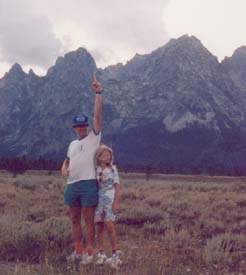
Two crazy people at the Tetons (I'm pointing to where my daughter, Mandy, and I climbed
that day)
A normal fault can produce some geologic features such as a graben.
The most famous are Death
Valley in California, the Dead
Sea, and the African Rift Valley.
 (animation)
(animation)
Most of Nevada has "strings" of mountain chains which seem to go forever. This is known as the "Basin & Range" province which are all produced by forces of tension.
 (animation)
(animation)

The Basin and Range Region from USGS
Ok, so how do you account for these forces of tension in the crust? It is believed that about 65 million years ago a section of subducted oceanic crust rested under the continental plate and began to sink into the mantle. Hot material from the mantle rose up into the void that was left behind. As this material moved up, it created forces of tension on the continental crust above.
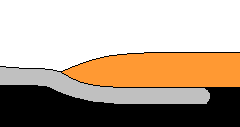 (animation)
(animation)
The last section in this unit deals with the last kind of mountain - Volcanoes!
ŠJim Mihal 2004, 2006 - all rights reserved